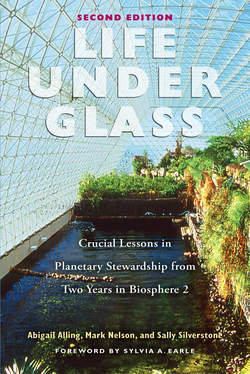Читать книгу Life Under Glass - Марк Нельсон - Страница 17
На сайте Литреса книга снята с продажи.
A NEW EXPLORATORY SCIENCE AHEAD OF ITS TIME
ОглавлениеThe project presented a stark alternative to how “business as usual” threatens our Earth’s biosphere because of our addictions to chemicals, plastics, fossil fuels, and technology that dominate our attention and divorce us from the natural world. Our wilderness biomes were off-limits to human expansion. They were valued for their own intrinsic beauty and uniqueness, and it was understood that biomes are the vital building blocks of a biosphere and critical for maintaining a healthy atmosphere and water cycles. Our rainforest was not cut down for short-term profits from timber and farming, nor did we slash and burn it or our savannah to create more farmland for growing food. Our mangrove marsh was not polluted with city and farming chemicals or other waste, nor was its water depleted for human use. Our coral reef was not overfished nor used as a dumping ground for trash or industrial and organic waste.
Our farm dramatically differed from industrial agriculture, one of the largest polluters and sources of greenhouse gases. Biosphere 2’s farm produced delicious organic produce that was not suspect because we didn’t (and couldn’t, since we’d be harming ourselves) use chemical fertilizers, pesticides, or herbicides. We recycled our wastes and returned the nutrients to the farm soils rather than letting them pollute ground and surface water and create marine dead zones. Our animals were champions in this recycling system; they were both our companions and part of a successfully working agricultural ecology.
Greenhouse gases and global climate change were not the front page issues that they are today due to decades since of accelerating man-made impacts. Yet back then, we were studying the cycles of carbon dioxide, methane, and nitrous oxide in Biosphere 2 as a normal atmospheric aspect of any living system. As we recount in the following chapters, one of the greatest challenges we faced was preventing a runaway rise in carbon dioxide from soil respiration and the imbalance with photosynthesis as Biosphere 2 began with small plants and trees, our initially “bonsai biosphere.” During those first two years, our plants doubled their biomass and a few years later, our soils reached more stable levels of organic matter. From necessity and with ingenuity, we developed numerous ways to help control our CO2 production and demonstrate how humans can become involved in managing the atmosphere and cooperate with natural systems, which have the capacity to sequester (store) and recycle these gases.
Perhaps it was inevitable that Biosphere 2 would become controversial once it surprisingly became headline news. To our dismay, even during our two years inside, the facile and endlessly repeated media story was to recount the problems and surprises of the first closure experiment and declare “Biosphere 2 is a failure.” Some even claimed Biosphere 2 was intended to be a substitute for taking care of Earth’s biosphere. On the contrary, Biosphere 2 showed us how irreplaceable our global biosphere is and underlined the necessity for humanity to co-evolve with it and become its stewards, not its destroyers. And with time, it became painfully obvious to the eight of us that most media reporting missed a most crucial point: it was above all else an experiment. We built Biosphere 2 not to demonstrate what we knew but to find out what we didn’t know, to learn from our mistakes and what the facility, with its complex ecological systems, would teach us.
Because it was cutting edge science, it was bound to step on toes, but who and what did it challenge? We inadvertently found ourselves in the middle of an ongoing fight among scientists. Some small-scale reductionist scientists literally couldn’t understand the systems level, holistic science of Biosphere 2. Arrogantly, they declared it not science at all! Worse, though, they perceived us as outsiders, mavericks, and not properly credentialed to undertake this project even though we had many world-class scientists, engineers, and institutions working with us to design and operate the facility. The fact that Biosphere 2 was privately funded and created outside the normal channels of government and university science grants, is the reason that the project moved so quickly. That independence allowed us to build a capable team and carry out the entire program which included the design, construction, and operation of Biosphere 2 for a price less than NASA would have spent just making the blueprints (as Joe Allen, a friend and NASA astronaut, told us).
The two-year Biosphere 2 experiment set world records for living inside a closed ecological system, eclipsing the six months that our Russian friends and collaborators had achieved in the most advanced experimental life support facility, Bios-3 in Siberia. That system imported some food and exported solid wastes. Biosphere 2 was the first closed ecological system that provided a complete balanced diet including animal products (meat, eggs and milk) and successfully treated and recycled all human wastes.
